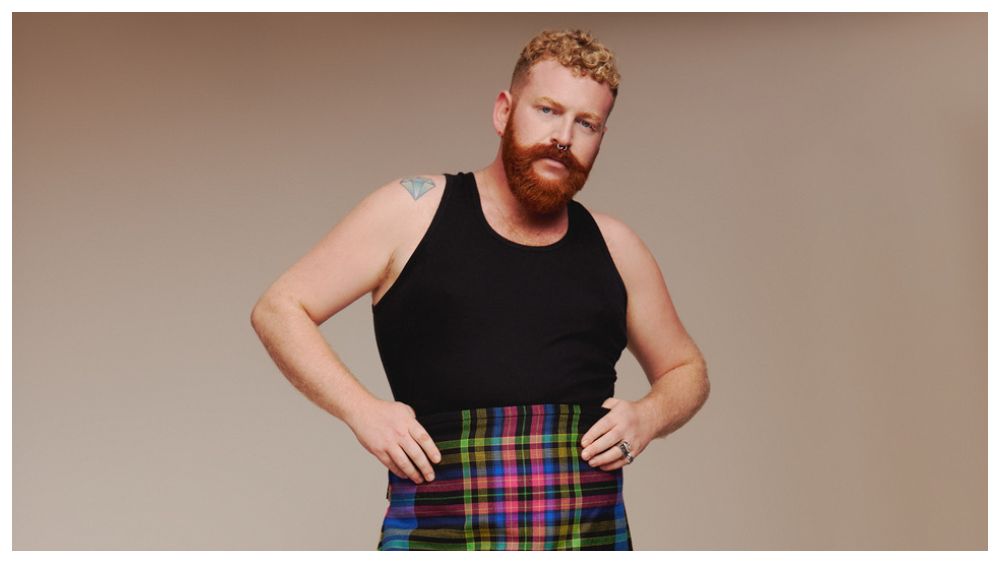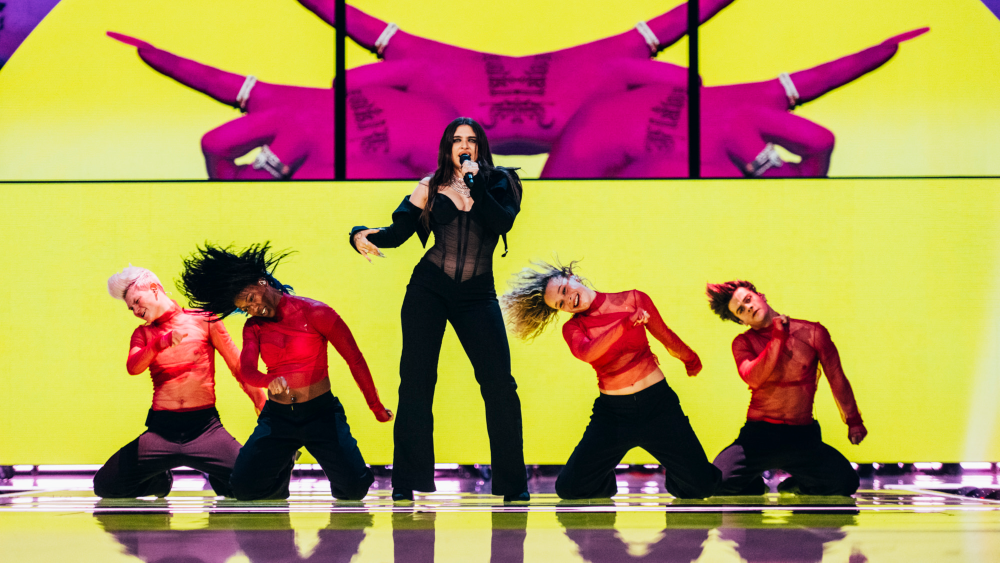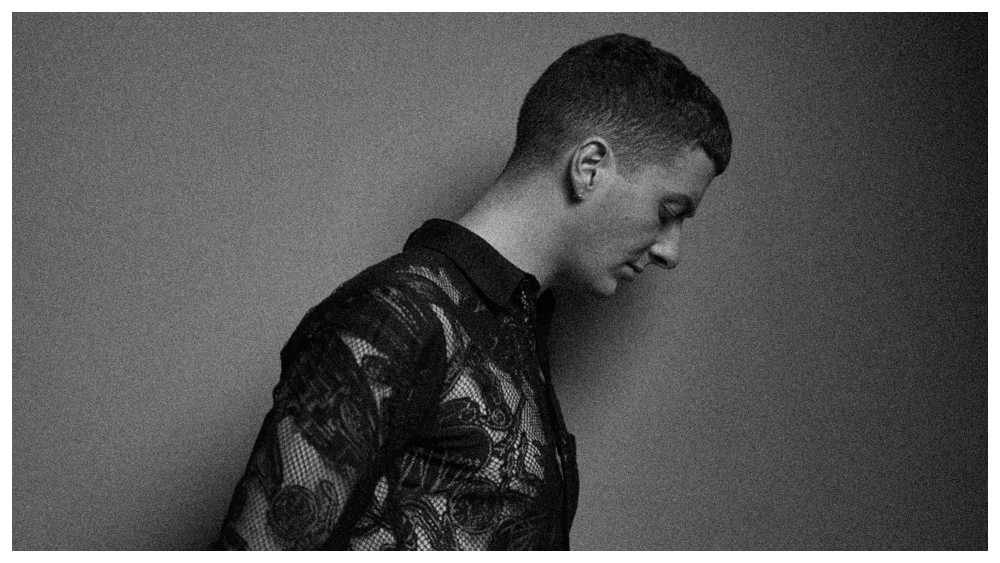Tom Rasmussen has no shortage of achievements to their name. From non-fiction books re-imagining love and marriage to spectacular drag performances, much of their work has involved thinking about and re-framing gender or sexuality norms in some way. Their debut album, Body Building, now bears the fruits of this labour.
Body Building is a radically trans album, skipping over entry-level pleas for tolerance and moving directly to the push for liberation. In spoken interludes between the tracks, notable trans voices Travis Alabanza and Shon Faye speaking about presentation and power, hope, vulnerability and threat. For Tom, the album sits on three layers – the deepest of which is the layer of transness, where the record speaks to the very specific and yet shared experience of being a person whose gender does not line up with society’s perception of their body.
‘It’s an album, hopefully, of bangers that anyone can listen to. And then it’s an album for people who’ve felt terrified and angry, who’ve felt like there’s no songs that are necessarily about those things. And then a lot of it is coded quite trans,’ says Tom. ‘I was writing from the experience of being in a really complicated place with my transness, and I was thinking of friends of mine who’ve always helped me and guided me creatively.’
Those friends include the poet and model Kai Isaiah-Jamal, who features on lead single Fantasy Island Obsession, the concept for which kickstarted a major part of the Body Building process. ‘I was in a transit van with Kai, and we were both like, “imagine if you made an island just of trans people, how amazing would that be?” And I was literally in the studio the next day and I wrote Fantasy Island Obsession,’ Tom says.
The single is a utopian vision, bright and brassy. Much of the record is like this – maximalist visions of euphoria and connection. Drawing on Tom’s years performing drag as Crystal and their connections to the fashion world, Body Building is a very textural record. It’s also born of violence and queer trauma, and the carefully curated collage lets this depth shine through without becoming overbearing.
'When I was thinking about the debut record I wanted to write, I wanted to write it for someone wearing those clothes walking down the street, who needs to put music on to slightly escape the street and escape the world around them.’
When beginning work on the album, Tom says they envisioned it as an exploration of violence in three acts. ‘Not just for this album, but for my whole life I’ve been obsessing over navigating violence. I just had these moments where I was like, “Ugh, fuck this.” The story, I did think of in a three-act structure really, which was escapism, reality and revenge.’
The narrative thread is held together by two tracks book-ending the album from opposite perspectives. Tom describes opener Borrow A Feeling as one of the only songs where they are ‘writing truly, honestly, about my feelings’ without adding a ‘flourish’, and it starts the process with a raw vulnerability. Musically gentle and lyrically raw, it taps into a pervasive sense of being followed, under threat. By the time the record closes with Look At Me, though, the feeling has been flipped. A challenge or a demand depending on how you look at it, Look At Me ascends past the fear and into defiance. Tom sings not of trans visibility but rather of trans euphoria – in their body, in their clothes, in their life.
The idea of fashion as an extension of the self comes up a lot in Body Building. In a spoken interlude on stomping dance single Street Violence, fashion designer and performer Michèle Lamy notes that ‘it’s nice to feel that [clothes] are a part of you, because then people know who you are.’
Like many people in the community, Tom’s relationship to clothes and embodiment is tied up in queerness. ‘For me and my friends and everyone I know, the experience of being in our twenties was either absolute euphoria because of how we looked and how we were seen, and absolute terror on the exact same day, in the exact same outfit,’ they say. ‘When I was thinking about the debut record I wanted to write, I wanted to write it for someone wearing those clothes walking down the street, who needs to put music on to slightly escape the street and escape the world around them.’
There is music out there that achieves that, but Tom points out that while there are some written by trans women, most others are by cis women with a cis audience in mind. ‘And I love that of course, but I wanted to write some bangers for trans people,’ they say.
'It wasn’t “boohoo, I’m queer” and it wasn’t “oh my god things are so hard for me”… It’s defiance, I guess.'
‘I also want to complicate the idea of visibility,’ they add. ‘I was really struggling with the idea of visibility after drag, because I quit drag in many ways because the visibility of it was quite limiting in the end. And so counter to the liberation I initially got into drag for. There has become this sort of anti-intellectual obsession that kind of corners us as queer people – and generally, anyone who’s been through something hard – into defining ourselves through our trauma and through things that have happened to us in exchange for status and money. I definitely have engaged in that practice, and really, I think it weakens the idea of liberation.’
Ultimately, Tom wants more for the queer community, and to reflect a different sort of vision of our lives. In Body Building, they approach something more truthful – a multi-faceted representation of trans joy, queer love, and defiance.
‘When I sat down and thought about what I wanted to say at 31 – first of all, that’s a really narcissistic process – but second of all, it wasn’t “boohoo, I’m queer” and it wasn’t “oh my god things are so hard for me,” even though a lot of the album is written from there,’ they say. ‘It’s defiance, I guess. I hope it goes beyond visibility to some sort of like, secret power.’





